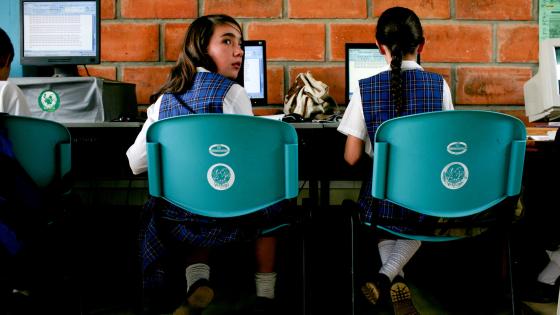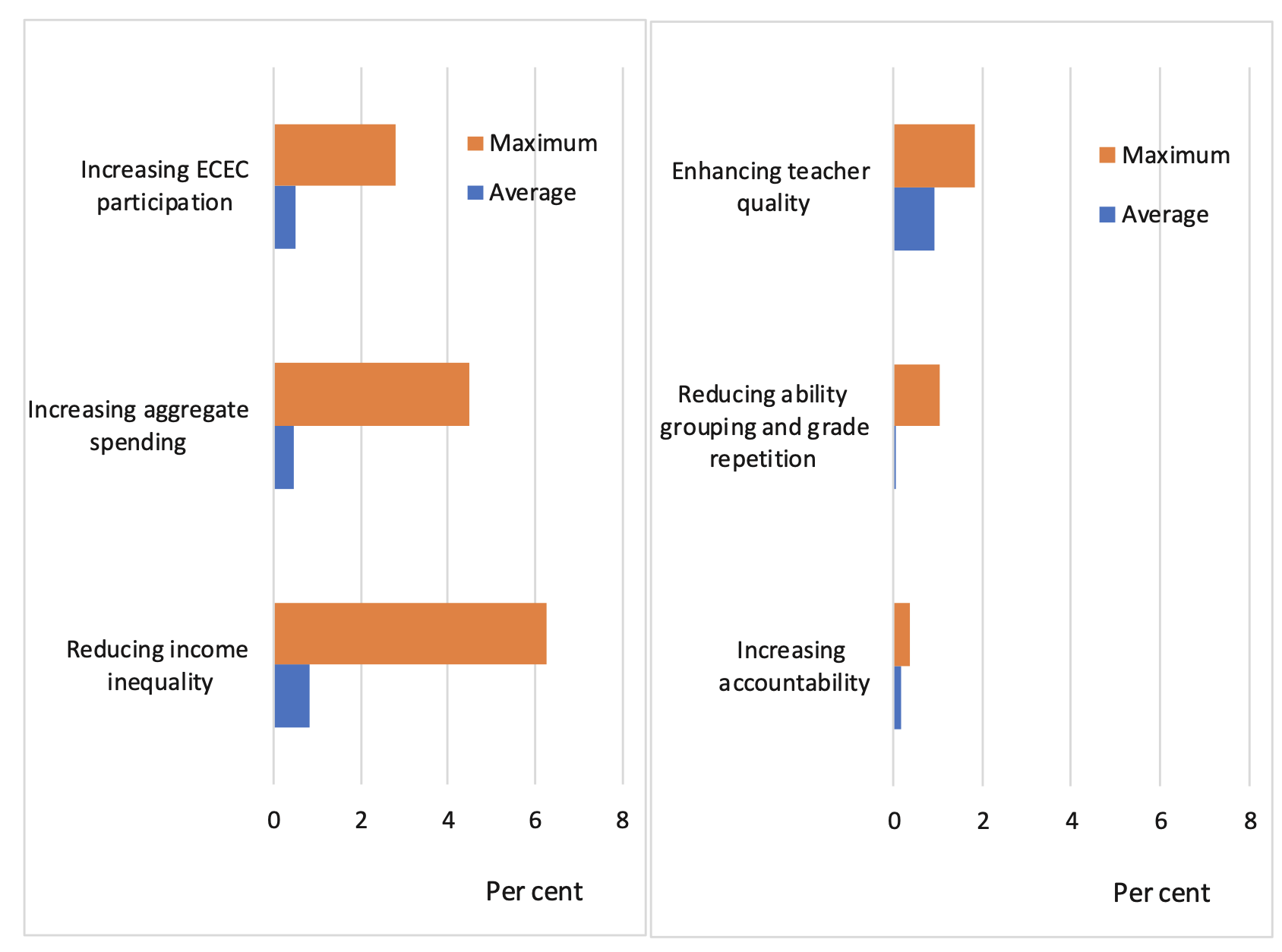The importance of education is frequently emphasised by policymakers. The OECD’s Programme for International Student Assessment (PISA) is often used to compare the educational performance of students at age 15 and to formulate policy advice. Recent OECD work not only quantifies the relationship between policies and educational performance, but extends it to a measurement of human capital and to the effect on macroeconomic productivity (Égert et al. 2023). Based on the OECD’s work, this column highlights policies with the greatest potential to raise productivity through the human capital channel. In particular, boosting participation in early childhood education and care, increasing education spending (for low spending countries), and reducing country income inequality could generate gains of several percentage points in the long-run productivity of some countries.
Early childhood education and care
At the student level, participation in early childhood education and care (ECEC) is the policy with one of the strongest links to student performance and productivity.
Participation in ECEC is widely recognised to have a positive effect on children’s cognitive, socio-emotional, and physical development (Heckman et. al. 2013, Braga et al. 2013, Dustmann and Cornelissen 2019, OECD 2022). Quality ECEC is particularly important for pupils from disadvantaged backgrounds, and those not fluent in the country’s official language (Phillips et al. 2017).
Data from 2021 show that 70% of OECD countries have already achieved an impressive 90% coverage for three-to-five-year-olds in ECEC. However, the same data suggest that coverage for one-fifth of OECD countries lies between 10 and 60 percentage points below this threshold, suggesting an increase in PISA scores of between 5 and 20 points and the potential for long-run gains in productivity of between 0.6% and 2.9% (Figure 1). Turkey and Switzerland have the most to gain from raising ECEC participation to this 90% threshold, with potential long-run productivity gains of 2.9% and 1.8%, respectively. But the US, Greece, and Costa Rica might also benefit, with long-run productivity gains of about 1.5%.
Figure 1 Aggregate productivity gains from policy reforms and reduced inequality
Note: Chart summarises authors’ scenario analysis (Égert et al. 2023). For most scenarios, low performing countries are expected to converge to the median OECD, but for teacher quality and accountability, low performing countries are expected to converge to the upper quartile.
Education spending
At the country level, education spending has a strong link with student performance and productivity.
The literature summarised in Smidova (2019) suggests that the relationship between the level of spending per student and student performance is non-linear, with any positive relationship weakening at higher levels of spending.
For countries with low education spending such as Colombia and Mexico, raising spending per student to the median OECD would boost PISA scores by between 25 and 30 points, with productivity gains reaching between 4.0 and 4.5%.
Education as a transmission channel between inequality and growth
At the country level, the links between growth and income inequality are complex, with causation running in both directions and a range of published empirical findings (Cerra et al. 2021, Lederman and Brückner 2015). However, a number of recent studies using cross-country data (Guillemette et al. 2017, Cingano 2014) suggest that inequality has a negative effect on growth, with macroeconomic effects that are often very large.
Recent work suggests that human capital is an important channel by which reduced inequality is transformed into higher growth performance. Based on the most recent available data, new analyses suggest that if countries with the highest levels of inequality as measured by the Gini coefficient – such as Colombia, Costa Rica, and Mexico – moved towards the OECD median, the expected gains in average PISA scores would be between 30 and 40 points, which if sustained could raise long-run aggregate productivity by 4% to 6%.
Other policies
Other education policies could generate large effects on the performance of individual pupils or schools, although the overall macroeconomic gains are less important than those from the policies considered above. These include:
- Enhancing teacher quality by elevating the share of teachers with master’s degrees from the lowest shares (Chile, Colombia, Denmark) to the OECD median would translate into productivity gains of around 1.8%.
- Reducing the share of schools separating students in all subjects or reducing grade repetition to the median OECD would translate into productivity gains of up to 1.0%.
- Reinforcing school accountability improves student performance (Hanushek et al. 2018). For countries with low accountability rules such as Austria, Belgium, or Finland, increasing the share of schools posting achievement data publicly to the upper quartile would be associated with long-run productivity gains of 0.3%.
References
Braga, M, D Checchi and E Meschi (2013), “Educational policies in a long-run perspective”, Economic Policy 28(73): 45–100.
Cerra, V, R Lama and N Loayza (2021), “Links between growth, inequality and poverty: A survey”, IMF Working Paper No. WP/21/68.
Cingano, F (2014), “Trends in Income Inequality and its Impact on Economic Growth”, OECD Social, Employment and Migration Working Papers No. 163, OECD Publishing, Paris.
Dustmann, C and T Cornelissen (2019), “The benefits of starting school early”, VoxEU.org, 08 June.
Égert, B, C de la Maisonneuve and D Turner (2023), “Quantifying the effect of policies to promote educational performance on macroeconomic productivity”, OECD Economics Department Working Papers No. 1781.
Guillemette, Y, A Kopoin, D Turner and A De Mauro (2017), “A revised approach to productivity convergence in long-term scenarios”, OECD Economics Department Working Papers No. 1385.
Heckman, J J, R Pinto and P Savelyev (2013), “Understanding the Mechanisms, through which an Influential Early Childhood Program Boosted Adult Outcomes”, American Economic Review 103(6): 2052–66.
Hanushek, E, L Woessmann and A B Bergbauer (2018), “Testing with accountability improves student achievement”, VoxEU.org, 18 September.
Lederman, D and M Brückner (2015), “Effects of income inequality on economic growth”, VoxEU.org, 07 July.
OECD (2022), “Using school funding to achieve both efficiency and equity in education”, Value for Money in School Education: Smart Investments Outcomes, Equal Opportunities, OECD Publishing, Paris.
Phillips, D A et al. (2017), “Puzzling It Out: The Current State of Scientific Knowledge on Pre-Kindergarten Effects”, Brookings Institution, 17 April.
Smidova, Z (2019), “Educational Outcomes: A Literature Review of Policy Drivers from a Macroeconomic Perspective”, OECD Economics Department Working Papers No. 1577.







